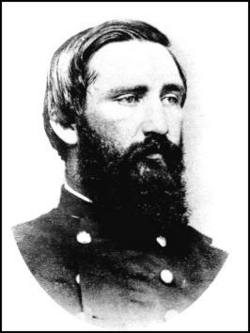William P. Sanders facts for kids
Quick facts for kids
William Price Sanders
|
|
|---|---|
 |
|
| Born | August 12, 1833 near Frankfort, Kentucky |
| Died | November 19, 1863 (aged 30) Knoxville, Tennessee |
| Place of burial | |
| Allegiance | United States of America Union |
| Service/ |
United States Army Union Army |
| Years of service | 1856–1863 |
| Rank | |
| Battles/wars | American Civil War |
William Price Sanders (born August 12, 1833 – died November 19, 1863) was a brave officer who fought for the Union Army during the American Civil War. He sadly passed away during the Siege of Knoxville.
Contents
His Early Life
William Sanders was born close to Frankfort, Kentucky. His father, Lewis Sanders, was a successful lawyer. His family moved to Natchez, Mississippi, around 1839, where William grew up.
William was a cousin of Jefferson Davis, who later became the president of the Confederate States. William's sister, Elizabeth Jane, married a wealthy businessman named James Ben Ali Haggin. The Haggin family lived right next door to the Sanders family in Natchez. William Price Sanders was often called "Doc," even though he was not a medical doctor.
Becoming a Soldier
Sanders attended the United States Military Academy at West Point from 1852 to 1856. He wasn't the top student, graduating 41st in his class. At one point, he almost got dismissed from West Point, but the U.S. Secretary of War, Jefferson Davis, helped him stay.
After graduating in 1856, Sanders served in the western parts of the United States, including Utah. He started as a second lieutenant in the 1st U.S. Dragoons. Later, he moved to the 2nd U.S. Dragoons.
Fighting in the Civil War
Even though some thought he might support the Southern states before the war, Sanders stayed loyal to the Union. He was promoted to first lieutenant in May 1861, and then to captain just four days later.
His unit, the 2nd U.S. Dragoons, was renamed the 6th U.S. Cavalry in August 1861. With this unit, he fought in important battles like the Peninsula Campaign and the Battle of Antietam.
After the Battle of Antietam, General Ambrose Burnside gave Sanders a new command in Ohio. On March 4, 1863, Sanders became a colonel of the 5th Kentucky Cavalry Regiment.
Leading Cavalry Raids
In April 1863, Sanders was put in charge of the cavalry (soldiers on horseback) in Central Kentucky. General Burnside then asked Sanders to lead a special mission into East Tennessee. His job was to find out where the enemy was and to mess up their communication and transportation lines. He also chased after Morgan's Raiders in July 1863.
In September 1863, Sanders became the chief of the cavalry for the Department of the Ohio. He then moved his troops to Knoxville, arriving on September 3, 1863.
Sanders was promoted to brigadier general on October 18, 1863. However, this promotion was never officially confirmed by the United States Senate before he died. From November 3 to November 18, 1863, Sanders led a group of soldiers in the Knoxville campaign.
His Final Battle
On November 18, 1863, William Sanders was shot by a sharpshooter. This sharpshooter was from the Confederate forces, led by Colonel Edward Porter Alexander. Interestingly, Alexander had been Sanders' roommate and classmate at West Point.
Sanders was fighting to stop Confederate soldiers from moving along Kingston Road, about one mile in front of Knoxville's defenses. People believe the sharpshooter was in the tower of Bleak House. Sanders was taken to the Lamar House, where he sadly died the next day in the bridal suite.
Sanders was first buried secretly in a church cemetery. Later, his body was moved to the Chattanooga National Cemetery. He was not married when he died, but he was dating a woman named Sue Boyd from Knoxville. She was a relative of a famous Confederate spy, Belle Boyd, but Sue Boyd was not involved in any spying against him and was very sad about his death.
About ten days after Sanders died, a major battle called the Battle of Fort Sanders took place. This battle was also part of the Knoxville campaign.
His Legacy
To honor William Sanders, a Union fort called "Fort Loudon" was renamed "Fort Sanders." The Fort Sanders neighborhood in Knoxville and the Fort Sanders Presbyterian Hospital are also named after him. Both are located where the old fort once stood.
A group called the Sons of Union Veterans of the Civil War has a chapter in East Tennessee named after "Colonel William P. Sanders." There is also a historical marker on Kingston Pike that shows where he was mortally wounded. This marker is on the property of the Second Presbyterian Church, which moved from downtown Knoxville to that spot.
Images for kids


